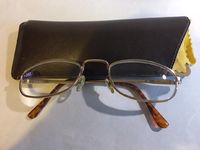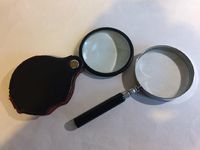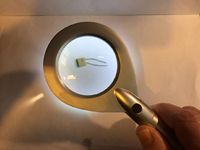Magnifiers and Inspection Aids
This page covers aids to seeing better.
Summary
Many faults are identified visually, but some are hard to see with the naked eye. A good light and some form of magnification makes it a lot easier.
Safety
- When working under a magnifier your face will usually be considerable closer to the work. Take extra care with sharp tools, and to avoid breathing fumes when soldering.
- Also, when working under a magnifier your peripheral vision may be restricted, limiting your view of nearby hazards.
- LED lamps are often extremely bright. Try not to let them shine directly into your face as they may cause temporary blind spots.
Introduction
Young people with normal sight can often focus on objects at a distance of 5 or 10cm, but our "near point" (as it's called) receeds with age. This varies from person to person but typically might start to become noticeable around the age of 40. The near point for a person with normal sight is generally considered to be around 25cm. Once your near point exceeds that your optomotrest may recommend reading glasses, but well before then you will benefit from some form of aid for very close work.
The simplest aid is good light, whether natural or artificial. Under strong light the pupil of the eye reduces in size, increasing the range of distaces that are in focus. Photographers will be familiar with the effect of reducing the aperture to increase the depth of focus, which is exactly the same effect.
The other simple aid is a magnifying glass. What this does is to bring the near point closer, allowing smaller details to be seen.
Inspection Lights
These come in many forms. When the view is restricted, for example to examine a screw head at the bottom of a recess, you generally need something small that you can hold close to your eye (but shining away from it) in order to shine onto the subject. In other situations, oblique illumination works best as it avoids bright reflections from shiny surfaces.
Modern inspection lights use LEDs, giving a very bright light.
A small LED torch is invaluable for general use. A head torch strapped onto the forehead leaves both hands free and gives illumination from a point close to the eyes.
Magnifiers
If you don't need glasses for distance vision a cheap pair of "readyspecs" makes close work very much easier. These are available without prescription from many outlets, at various strengths. Try a few and select a pair that allows you to see clearly at the closest distance you could comfortably work. The strength is measured in Dioptres, and you will probably find a value of +3 to +4 will work well. If your near point without glasses is 25cm, a +4 pair will bring this in to half that distance.
Magnifying glasses come in a rage of sizes, strengths and styles. The strength is given as a magnification, e.g. 2x. This means that for a person with a near point of 25cm, held close to the eye, it will bring your near point to half of that, resulting in an image twice the size on your retina, hence the +4 dioptre glasses are the same as a 2x magnifying glass. Beyond around 5x the aberations inherent in a simple lens start to reduce its usefulness. Magnifying glasses with higher quality compound lenses are available at a price.
For most purposes you will get the best result by holding a magnifying glass as close to your eye as you comfortably can.
You may be able to find a magnifying glass with built-in illumination. These are often used by the partially blind.
A jeweller's eye loupe is extreemly useful, especially for very close inspection. One of 5x magnification works well. With a little practice you can hold it in your eye socket leaving both hands free.
External links
- External links (if any) as bullet points.
- If non, delete this section.


